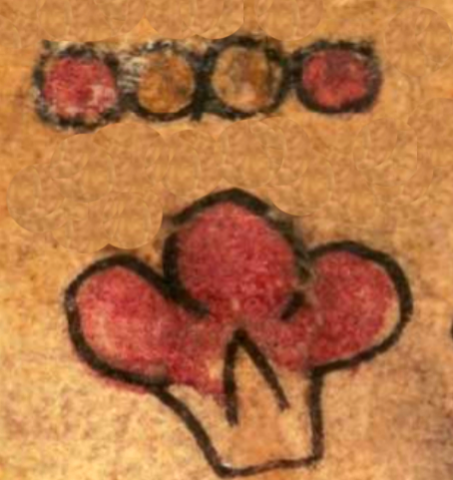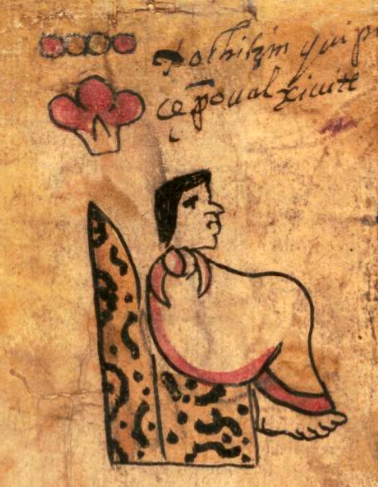Nahui Xochitzin (CQ)
This simplex glyph-plus-notation stands for the personal name Nahui Xochitzin, which is the reverential form for Nahui Xochitl (Four Flower). This is a day sign in the 260-day divinatory calendar, called the tonalpohualli in Nahuatl. Both Nahuas and Mixtecs included calendrics in their religious views of the cosmos.
The notation for four appears at the top of the glyph in the form of four circles drawn in ink and filled in with colorants, red, yellow, yellow, and red. The flower has three predominant petals in red and a white, tripartite sepal at the base of the flower.
Stephanie Wood
Nahui Xochitzin is a name from the calendar, suggesting that the man who bore the name (see the contextualizing image) was born on that day. The reverential ending to the name (-tzin) fits with the appearance of the man, who sits on a jaguar skin-covered throne (icpalli) and wears the cape called a tilmatli. Often, there are historical and religious associations with certain names. Nahui Xochitl appears in the Codex Chimalpopoca in association with a calamitous time of flood and destruction. Sebastián van Doesburg (see Bibliography) discusses Four Flower Xochitzin as married to a woman named Tepetl (Pedernal) and governing Tecamachalco (modern-day Puebla) between 1507 and 1520.
Stephanie Wood
xochitzin
Xochitzin
Stephanie Wood
covers ruling men and women of Tecamachalco through 1593
Stephanie Wood
flowers, flores, ones, unos, tlahtoqueh, tlahtoani, numbers, números, días, days, calendarios, calendars, dates, fechas

nahui, four, https://nahuatl.wired-humanities.org/content/nahui
xochi(tl), https://nahuatl.wired-humanities.org/content/xochitl
tonalpohual(li), 260-day calendar, https://nahuatl.wired-humanities.org/content/tonalpohualli
Cuatro Flor
The Codex Quetzalecatzin, aka Mapa de Ecatepec-Huitziltepec, Codex Ehecatepec-Huitziltepec, or Charles Ratton Codex. Library of Congress. https://www.loc.gov/item/2017590521/
The Library of Congress, current custodian of this pictorial Mexican manuscript, hosts a digital version online. It is not copyright protected.





